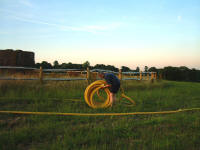
|
|
||||
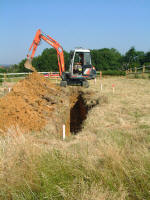
|
|
||||
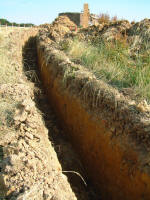
|
|
||||
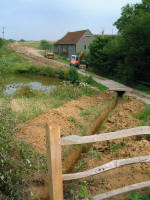
|
|
||||
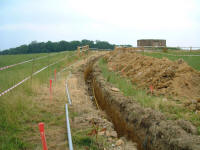
|
|
||||
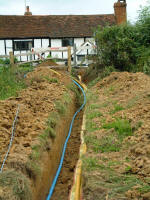
|
|
||||
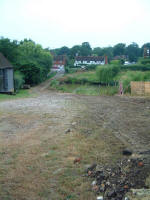
|
|
||||
Don't forget you can CLICK on a photo to view a larger image.
3rd - 17th July 2006 - Installation of services return to Latest News
At last someone else was doing some work - this time a local contractor. After months of
discussion and often frustrating phone calls with the utility companies', work started on
3rd July with myself and Bridget rolling out the gas pipe and ducting - no easy task with
220 metres of coils wanting to spring apart into a knotty mass! The next day saw the arrival
of the contractors to dig an equally long trench; this had to be fairly deep in places to allow
for the track to be installed over the top in the near future. This I think was always going to
be the messiest stage of the project as can be seen from the photographs, but no sooner was
the trench dug and the services installed that it was filled in again. It just remains for the
services to be connected at the road and mill end.
27th May 2006 - Metal detecting back to top of page
Although we tried to be as careful as possible to look for any 'finds' when the base was dug
out, I was convinced that some items were missed. After searching the internet for metal detector
clubs I hit upon the email address of an enthusiast in Horley. A few emails later, Andy Humphrey
very kindly agreed to come and see what could be found. Not much at first, but soon the detector
started picking up interesting signals and apart from the odd nail or piece of lead, a very good
collection was amassed after three hours or so. This mainly consisted of shutter castings from
the sails, which interestingly were concentrated near one side of the base - it later transpired that
this was the area that the sails last faced and hence bits dropped off them at this point! Amongst
the other oddments was almost a complete key, clearly an old one and possibly one of the original
mill keys!
When I have sorted the finds I will post some pictures, but meanwhile a special thanks to Andy
for his help.
19th March 2006 - Fencing is now complete back to top of page
|
|||||
|
|
|||||
25th February 2006 - Excavating infill from within and around the brick base back to top of page
What fantastic luck we had with the weather today, blue sky and plenty of sun.
This encouraged a great turnout of members from the Sussex Mills Group (SMG) for a
digging session. SMG volunteered their services sometime ago to excavate the remaining
infill within the brick base and also to remove the accumulated earth from around the outside.
It was hoped that some artefacts would also be recovered and we were in luck; finds
included more sail shutter ironwork, some old bottles and a piece of millstone.
|
|
||||||
|
|
||||||
|
|
|
||||||
18th February 2006 - Marking out of boundary and track back to top of page
At last after several weekends of work I have finished marking out the track and boundary.
The track follows the original line across the field and just to prove it, many of the pegs
struck hard ground quickly; the line of the track was gleaned from an old Ordnance Survey
map. I first established a trig point 13m to the north of the mill and from this point I used a
laser level and marking tape to fix the position of all markers from dimensions and angles
that I had worked out on my survey drawings.
|
|||||
|
|
|||||
15th January 2006 - Excavating inside the base. back to top of page
Beneath the original wooden floor level are the sleeper walls, which originally supported the joists
for the floor. When the base was converted for farm use in the late 1940's the ground between
these sleeper walls was filled in and levelled off. We have been digging this infill out down to the
original ground level during with we have found an assortment of ironwork. Unfortunately most
is not recognisable except for the shutter cranks below.
|
|
||||
|
|
||||
|
|
||||
|
|
|||||